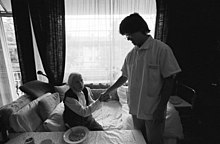Ambulant care
Outpatient care is the professional nursing and domestic care of people in need of care in their home environment, which is provided by mobile (outpatient) care services. In Switzerland the name Spitex is used (external care), in Austria a distinction is made between home help and home nursing.
The aim of outpatient care is that people in need of care can remain in their home environment. To do this, the mobile service visits the client at home several times a week or several times a day. The prescribed care, examination and treatment services are provided within a certain time frame.
Some outpatient services have additional qualifications, for example in palliative care for the seriously ill and the dying . As part of specialized outpatient palliative care , additional services can be provided that go beyond general basic and treatment care . Out-of- hospital intensive care as a further specialization of outpatient nursing enables seriously ill or long-term ventilated patients to be cared for in the home environment.
Depending on the level of care and medical prescription, outpatient care services are taken over by the respective cost bearers.
Germany
Scope of services
According to § 37 SGB V , insured persons in need of care are entitled to outpatient nursing care by suitable nurses. Contrary to the knowledge of nursing science , the text of the law distinguishes between “basic” and “treatment” nursing without defining these terms. To cover basic or domestic care, this can be cash benefits or outpatient care benefits in kind. The treatment care is offered as a support service for outpatient medical care only because of a doctor's prescription.
statistics
In 2009, 69% of all those in need of care (1.62 million) were cared for in their home environment. In the case of 1,066,000 people in need of care, it can be assumed that they were cared for by relatives alone, as they only received care allowance . The care of the remaining 555,000 people in need of care was provided jointly or entirely by outpatient care services. Among the approved outpatient nursing services in 2009, the majority of 62% were privately owned and 37% were non-profit organizations. However, if the proportions of the types of provider are related to the size of the facilities, then the proportion of private individuals is likely to be somewhat lower, and that of non-profit and public facilities somewhat higher, since private operators are overrepresented in facilities that are smaller in terms of staff numbers and number of patients. Since, however - a fear that has been increasingly communicated in recent years - the familial / informal and professional care potential no longer appears to be sufficient to cover the expected need for help of the aging population, there is increasing voluntary engagement in taking on care / care activities for older people People required. This is not only at the expense of satisfying the needs of those who need these activities, it also reproduces gender-specific inequalities from family and professional care.
Stefan Sell publishes figures on the age structure in outpatient care in Germany in May 2019 . According to this, around 40 percent of nurses were older than 50 in 2017.
Austria
According to the Federal Long-Term Care Allowance Act, depending on the level of care, care allowance is usually paid out by the pension insurance provider; those in need of care in care level 7 receive the maximum amount. The recipient can freely dispose of the care allowance in order to secure the help that meets his needs.
Home help and home nursing are offered as outpatient nursing support:
Heimhilfe provides help with housekeeping (e.g. shopping and cooking), helps with personal hygiene and with getting dressed and undressed, and accompanies you to the doctor or pharmacy. These activities may be carried out by home or care assistants .
Home nursing is carried out by qualified nursing staff who only provide medical services and qualified nursing services. It has been a compulsory social health insurance benefit since 1992. The services of home nursing include the preparation and administration of drugs and injections, wound care and dressing changes; Blood pressure control, blood sugar measurement, insertion of catheters and probes, activating care, mobilization and pain relieving care.
literature
- Bernhard Mann : Problems in home care. Aspects of the impact of the new regulation on the Social Security Code V. (= German University publications. Volume 509). Egelsbach, Frankfurt am Main 1994, ISBN 3-89349-509-6 .
- Anne Buhrfeind: To die in the hospice or at home? How does palliative medicine help - an aid. In: Chrismon . November 21, 2014.
- Yvonne Rubin: Volunteering in 'caring communities'. A gender critical analysis of voluntary care work for the elderly. Barbara Budrich Verlag, Opladen, Berlin and Toronto 2018, ISBN 978-3-8474-2242-6 .
Individual evidence
- ↑ Michael Seidel: Treatment care in the disabled aid - guidelines for inpatient facilities of the working group health policy of the professional associations of the disabled aid, 2009, p. 7. (PDF; 615 kB) Retrieved on January 31, 2015 .
- ↑ a b Federal Statistical Office: Care statistics 2009
- ↑ Rubin 2018
- ↑ From the shadowy world into the spotlight of the nursing emergency: Outpatient nursing services , blog article from May 1, 2019 (Link checked on May 1, 2019)
- ↑ Handbook of Austrian Social Insurance 2018. pp. 101-102 ; accessed on December 1, 2018
- ↑ Online guide to care allowance from the Austrian social insurance system ; accessed on December 1, 2018
- ↑ Careers and support professions. on pflege.at ; accessed on December 1, 2018
- ↑ Austrian social insurance ; accessed on December 1, 2018
- ↑ Caritas care ; accessed on December 1, 2018
Web links
- Care at home ( Federal Ministry of Health (Germany) )
- Grades for outpatient care services ( consumer advice center Rhineland-Palatinate)
